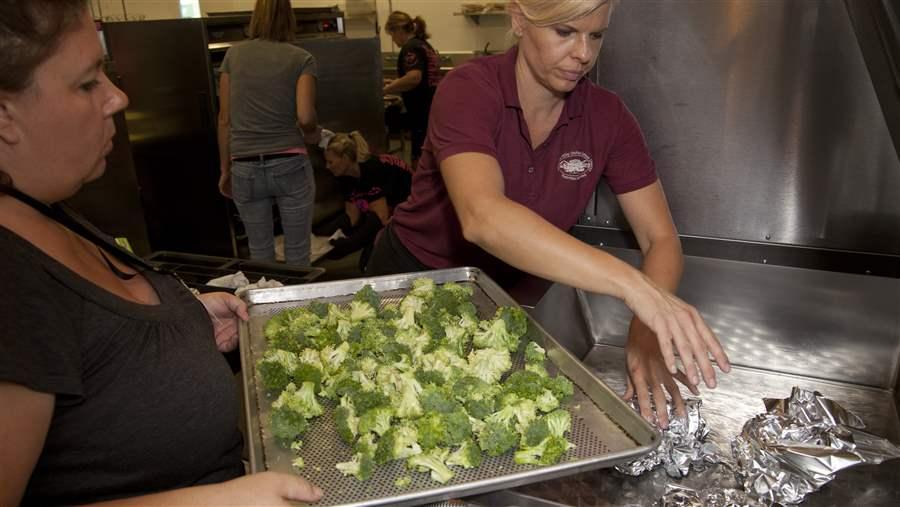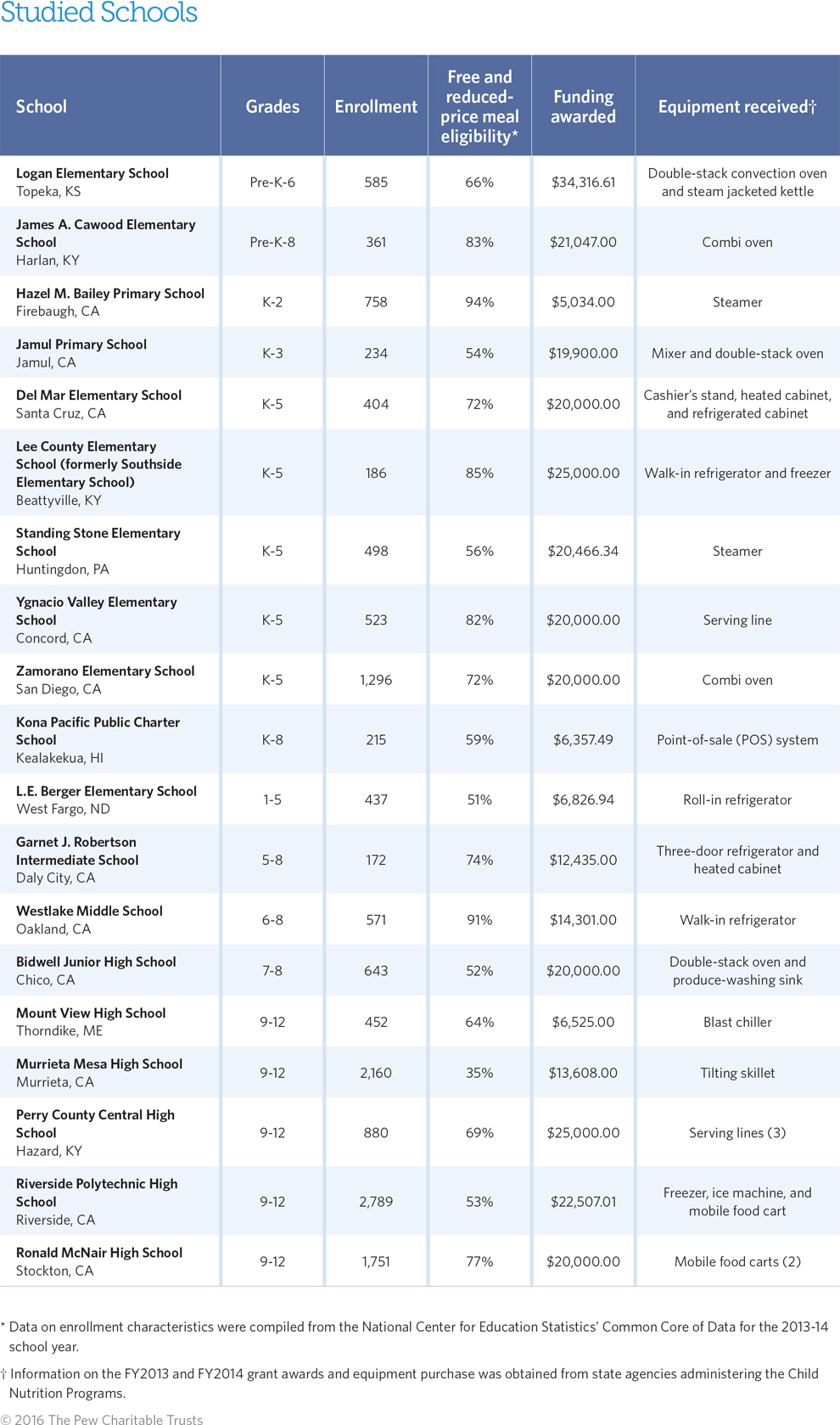USDA’s School Kitchen Grants Benefit Meal Programs and Students
Federal funds help schools use more fresh ingredients and improve service
 © The Pew Charitable Trusts
© The Pew Charitable TrustsStaff at Murrieta Mesa High School in California use a tilting skillet, purchased with a U.S. Department of Agriculture kitchen equipment grant, to prepare healthy, made-from-scratch entrees and side dishes.
Overview
The National School Lunch Program is turning 70 in 2016, and kitchens in many of the more than 95,000 schools that participate in the program are nearly as old. Aging infrastructure and equipment, much of it designed to heat or handle pre-packaged rather than fresh foods, pose significant barriers to school districts’ efforts to adapt to the preferences and dietary needs of today’s students. To address these challenges, Congress appropriated nearly $200 million over the past six years for U.S. Department of Agriculture (USDA) kitchen equipment grants, which have helped thousands of schools purchase needed upgrades.
The Kids’ Safe and Healthful Foods Project—a joint initiative of The Pew Charitable Trusts and the Robert Wood Johnson Foundation—commissioned a series of case studies to explore the effects of this federal funding on students and meal programs.
Researchers interviewed food service directors, school administrators, and students from 19 schools in seven states during 2015, and visited the campuses to collect more information. This brief serves as a companion to the individual school case studies, providing background on the grant program and summarizing the findings of an analysis of trends across the schools studied.
The research found that equipment purchased with USDA grant funds has helped schools overcome many of the challenges that meal programs reported in the Kids’ Safe and Healthful Foods Project’s 2012 national survey.1 That earlier study found that outdated and poorly equipped food service facilities hindered staff efforts to prepare and efficiently serve healthy and appetizing meals. The survey also found that fewer than half of programs have a budget for equipment upgrades, and so many make do with inefficient and expensive workarounds.
For example, schools without adequate refrigeration and storage may resort to piling fresh fruits and vegetables in milk crates and small coolers or taking more frequent and costly deliveries of perishable items. Similarly, kitchen space constraints force some schools to prepare meals in shifts, increasing labor costs and pushing lunch periods earlier or later in the school day. Cramped serving lines slow students’ pace through the cafeteria, leaving less time to eat and discouraging many from choosing a school meal.
Just one new appliance or serving station can have considerable benefits for meal programs and students. Overall, purchases made with USDA equipment grants have helped schools improve nutritional quality and variety, entice more students to eat school meals, and operate more efficiently and cost-effectively. Access to kitchen-upgrade funds such as these grants allows schools to better support children’s health and to run financially sound meal programs. For example:
- Hot holding cabinets keep foods at optimal serving temperatures without drying them out, allowing staff to prepare dishes in advance while maintaining the meals’ appeal.
- Blast chillers freeze or cool foods quickly and safely, preserving freshness and reducing spoilage.
- Combination (combi) ovens bake, roast, grill, steam, braise, blanch, and poach foods faster and maintain more vitamin and nutrient content compared with many traditional cooking methods.
- Mobile food carts enable schools to serve students in more places on campus, making it easier for children to get food and reducing congestion in cafeteria serving lines.
- Modern point-of-sale (POS) software systems help reduce the time students spend in line in the cafeteria and improve the accuracy of schools’ financial and inventory records.
A brief history of federal kitchen equipment funding
A 2012 survey by the Kids’ Safe and Healthful Foods Project found that 88 percent of districts needed at least one piece of kitchen equipment to help them meet National School Lunch Program nutrition standards, which ensure that children are offered meals with lean protein; fruits; vegetables; whole grains; and limited amounts of saturated fat, sugar, and sodium. Yet only 42 percent of school meal programs have a budget for equipment purchases, and of those less than half say that their resources are adequate to cover all their needs.2
This imbalance between local needs and resources is partly the result of inconsistent support from federal policymakers. Congress first provided assistance to schools to purchase kitchen equipment and renovate cafeterias 50 years ago through the Child Nutrition Act.3 However, for almost three decades starting in the early 1980s, lawmakers included no funding for these efforts in their annual spending bills. Then, as part of the American Recovery and Reinvestment Act of 2009, Congress appropriated $100 million for equipment grants, and in the years since, nearly another $100 million has been approved, including $30 million for fiscal year 2016.4 The USDA distributes these dollars to state agencies that in turn award grants of at least $5,000 to eligible schools.
Thanks to this and other assistance and the determination and creativity of school food service professionals, 98 percent of schools were serving meals that met national nutrition standards at the end of 2015.5
Schools improve cooking, storage, and customer service with new equipment
The equipment that the studied schools purchased with USDA funds generally fit into one of three categories:

Cooking equipment: combination ovens, steamers, tilting skillets
Eight schools in the study purchased equipment to help them move away from pre-processed heat-and-serve items and instead do more quick and healthful from-scratch cooking using fresh ingredients. At Murrieta Mesa High School in California, the kitchen had been outfitted exclusively to prepare heat-and-serve meals. The school used a USDA grant to purchase its first piece of scratch-cooking equipment, a tilting skillet, that it uses to cook large amounts of food quickly and evenly and then to easily move the prepared items to serving pans. The school uses the skillet nearly every day to make healthy chili, carnitas, chicken fajitas, and other entrees that are popular with students and reflect the cultural heritage of many families in the district.

Service equipment: serving lines, point-of-sale systems, mobile carts
Six schools purchased equipment to improve the meal-service experience. At Perry County Central High School in Kentucky, students wanting self-serve salads had to go to a small salad bar in a remote corner of the cafeteria, away from the entree serving lines, increasing wait times and deterring many from choosing salad. With USDA funds, the program was able to purchase and install three new serving lines, each with a large, integrated salad bar. The new layout encourages students to make healthier choices by displaying fruits and vegetables attractively and accessibly, and it also helps speed students through the meal selection process, leaving them more time to eat.

Refrigeration and frozen storage: walk-in refrigerators, freezers, blast chillers
Five schools purchased equipment to expand energy-efficient storage, mostly to accommodate increased quantities of fruits and vegetables. L.E. Berger Elementary School in North Dakota was determined to offer more fresh fruits and vegetables, but the school’s old walk-in refrigerator was awkwardly located behind a store room. The configuration forced the kitchen crew to waste time and effort moving food to and from the cooler, and the extra trips through the unit’s door, which included a step that made it impossible to use wheeled carts, led to difficulties maintaining safe food storage temperatures. The school used its USDA grant to purchase a roll-in refrigerator to improve efficiency in the kitchen. Staff can now easily transport large amounts of food with less effort and store more fruits and vegetables without compromising the temperature, all of which has given West Fargo’s food service director the confidence to purchase locally sourced produce and incorporate it into school menus.
Kitchen equipment use extends beyond lunch and breakfast
For many schools, equipment purchases fit into a larger plan to make the cafeteria environment healthier and ensure that students are well-nourished and ready to learn. Additionally, most of the districts examined participate not only in the National School Lunch Program, but also in other child nutrition initiatives, such as the Fresh Fruit and Vegetable Program, the Summer Food Service Program, and the Child and Adult Care Food Program.6 This means that the benefits of kitchen equipment upgrades typically extend beyond lunch and breakfast service, to include snacks, after-school meals, and even dinners.
Jack Miniard, food service director for Harlan County Public Schools in Kentucky, has seen many benefits accrue from the purchase of a new double-stacking combination oven for the district’s James A. Cawood Elementary School. “The kids are eating more fresh vegetables, and that’s a boon for local growers and children’s health, as well as a less expensive alternative to depending upon frozen vegetables,” said Miniard. “But best of all, the students—and teachers, who now often eat in the cafeteria too—are being treated to ‘real’ food that they like, and that fuels them up for all the opportunities our school has to offer.”
Conclusion
Nationwide, nearly 100,000 schools participate in the National School Lunch Program, and no two manage their kitchens, plan their menus, or balance their budgets in exactly the same way. Many of them, however, face common challenges in financing kitchen equipment purchases and cafeteria enhancements. Congress’ recent appropriations for USDA-administered school equipment grants have helped thousands of schools make upgrades that allow them to cook a greater variety of fresh and healthy dishes, boost student participation in meal programs, and reduce operating costs. Providing some predictable sources of funding for these important investments can add momentum to schools’ tremendous progress toward more healthful foods and drinks that meet the nutritional needs of all students.
Appendix: Methodology
Nineteen schools were selected from the list of USDA FY2013 and FY2014 awardee schools compiled by the state agencies administering the Child Nutrition Programs. Individual schools were chosen to represent a range of sizes (total student enrollment), grade levels (elementary, middle, and high school), and community types (urban, suburban, and rural). Schools were contacted to verify the data supplied by the state agencies and to ascertain the school’s willingness to be part of the study. A trained interviewer visited each school at least once, and in some cases twice, to collect information before and then after the equipment was purchased and put to use. Interviews were conducted with the school staff person who had primary authority over the purchase, installation, training for, and use of new food service equipment—in most cases, this was the district’s food service director. Additional information was collected from school administrators, teachers, and students.

Endnotes
- The Pew Charitable Trusts, Kids’ Safe and Healthful Foods Project, Serving Healthy School Meals: U.S. Schools Need Updated Kitchen Equipment (2013), http://www.pewtrusts.org/en/research-and-analysis/reports/2013/12/18/serving-healthy-school-meals-kitchen-equipment.
- Ibid.
- U.S. Department of Agriculture, Food and Nutrition Service, “National School Lunch Program (NSLP): Child Nutrition Act of 1966,” accessed March 21, 2016, http://www.fns.usda.gov/nslp/history_6.
- U.S. Department of Agriculture, Food and Nutrition Service, “ARRA: American Recovery & Reinvestment Act of 2009,” accessed March 25, 2016, http://www.fns.usda.gov/arra/nslp; U.S. Department of Agriculture, Food and Nutrition Service, “2016 NSLP Equipment Assistance Grants,” accessed March 21, 2016, http://www.fns.usda.gov/2016-nslp-equipment-assistance-grants.
- U.S. Department of Agriculture, Food and Nutrition Service, “School Meal Certification Data (as of December 2015),” accessed April 26, 2016, http://www.fns.usda.gov/school-meals/school-meal-certification-data.
- The Fresh Fruit and Vegetable Program (FFVP), Summer Food Service Program (SFSP), and Child and Adult Care Food Program (CACFP) are federally assisted child nutrition programs administered by the Food and Nutrition Service at the U.S. Department of Agriculture. The FFVP provides free fresh fruits and vegetables to students in participating elementary schools during the school day. The SFSP ensures that low-income children receive nutritious meals when school is not in session. Through CACFP, child and adult care institutions and family or group day care homes receive aid to provide nutritious foods through meals and snacks. U.S. Department of Agriculture, Food and Nutrition Service, “School Meals: Child Nutrition Programs,” accessed April 20, 2016, http://www.fns.usda.gov/school-meals/child-nutrition-programs.


School Nutrition Gets a Boost From USDA Kitchen Equipment Grants
School Nutrition Gets a Boost From USDA Kitchen Equipment Grants
Learn More

States Need Updated School Kitchen Equipment
Eighty-six percent of schools in the United States are serving healthy lunches, but many could do so more effectively and at less cost if they had updated equipment and infrastructure.
Learn more

What Does a School Kitchen Need?
Case studies show how federal investments help schools serve healthier meals
Learn more.





